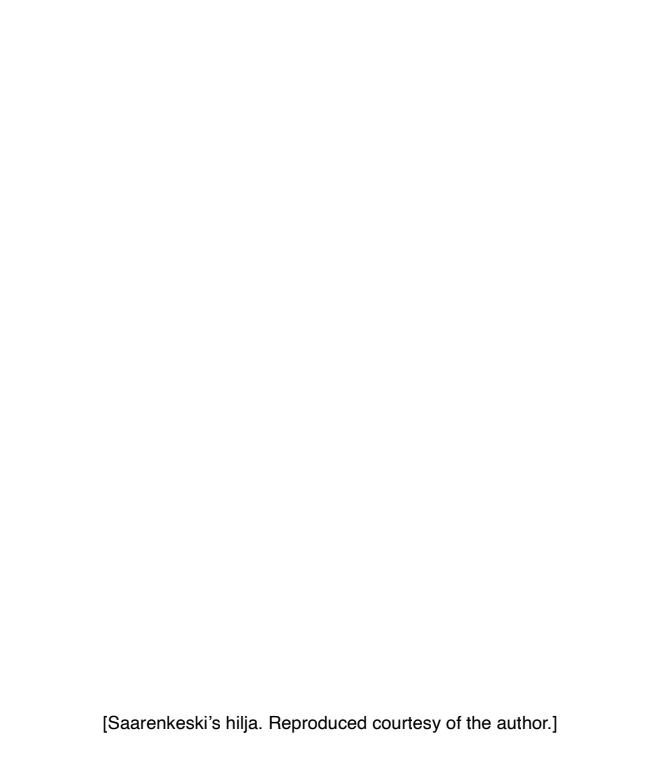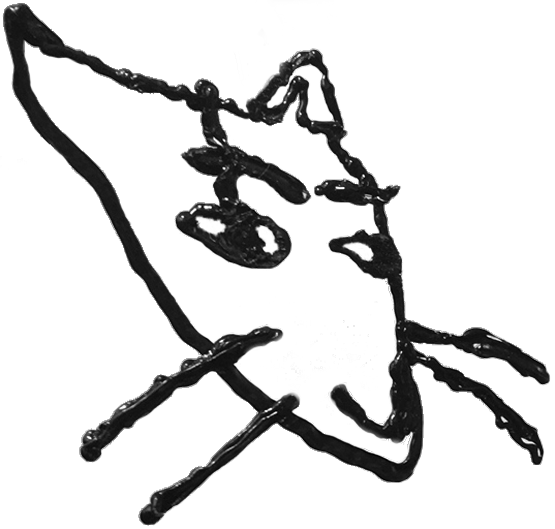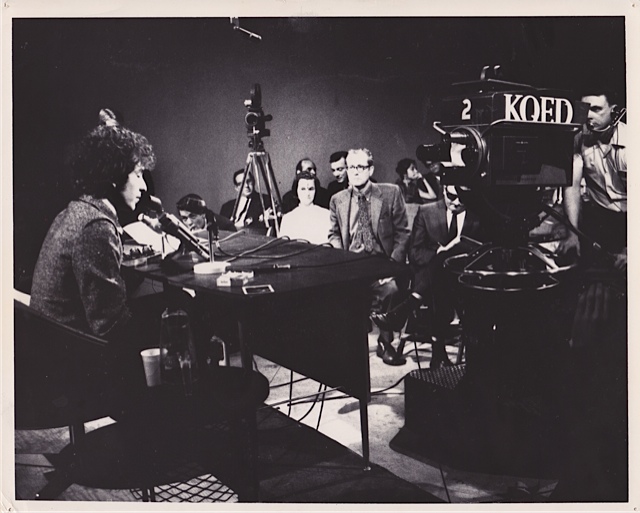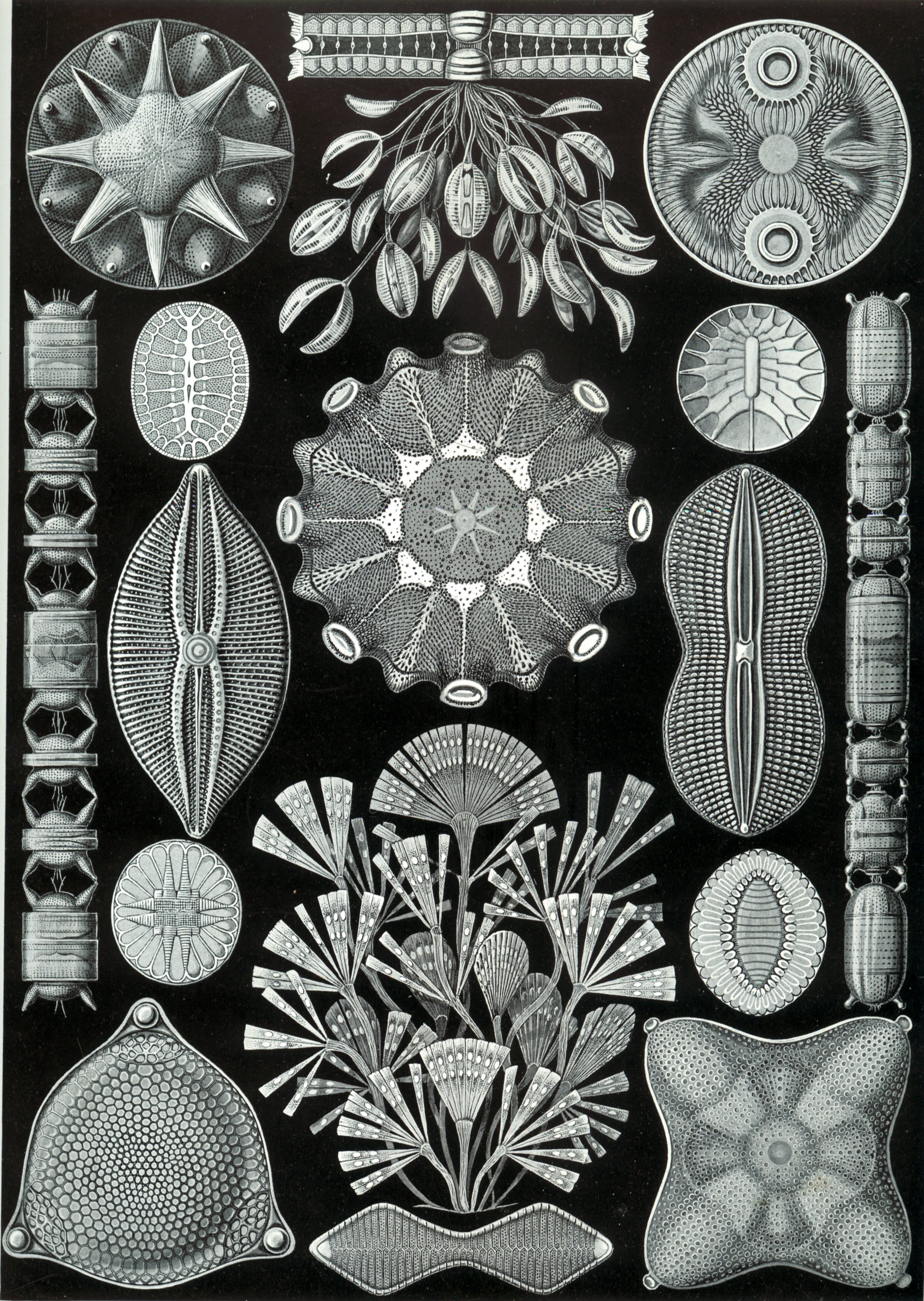The following is an excerpt from a physical volume containing 5 Wikipedia articles and 5 biographies, available here: https://www.mouse-magazine.com/shop/
Hilja
Hilja is an exclusively Finnish, wordless genre of poetry. Even more extreme in its simplicity than the Japanese haiku, with which it shares some aesthetic similarities, it consists solely of silences for which the textual component, if present, is a contextualizing preface, often but not always provided by the author of the hilja.
Where in a haiku for example a frog would croak and thus enter into a dynamic relationship with its environment, a hilja in contrast would make a (non)statement, such as, to retain the frog and use a famous hilja as an example, "[the night was silent; even the frog did not dare to jump on such thin ice]", placed according to hilja formalism between brackets to denote silence or as if to place the statement outside of language.
Some hilja are commemorations or records of specific silences, with disputed status as literature even within Finland. A common example that divides scholars on the issue of whether it should be considered literature goes "[Vääksy Street 15, at the bus stop, 1/2/1988. Markku and Petteri. 2 hours 15 minutes]". A silence, its location, date, participants, and duration. It’s not known what the further context of this famous silence is, which has only increased its fame; it’s become a common ice breaker and a means of passing time in Finland to speculate on it.
While hilja are mostly known and practiced in Finland, some argue hilja have influenced global art trends. According to an anecdote often repeated in Finland, John Cage originally got the idea for his famous piece 4′33″ when visiting an evening of hilja recitals in Tampere in August, 1950. Cage's piece subsequently gained recognition around the world and immense popularity in Finland, remaining among the top ten bestselling records for more than 30 years. Every child in Finland knows how to play 4′33″ by age ten, as it is taught in elementary school music class, where children stand in silence with recorders in hand for its duration every day. Occasionally, kids being kids, someone breathes through the recorder or makes some such noise-making mistake, and everyone in class turns to look at them, but the teacher gently says, after the piece is over, that it wasn’t a mistake, but should also be considered part of the piece.
Sometimes 4′33″ is performed as an accompanying piece of music in hilja recitals. Some Finnish musicologist-folklorists even classify 4′33″ itself as a hilja, especially considering its origins at a hilja recital, rather than as belonging to western classical music. The academic, hiljaist, and scarf model Kalevi Syksy has complained of the use of 4′33″ as accompaniment to hilja for this reason, saying performing two hilja at once "creates a dissonance of the worst kind, one that cannot even be heard".
At the other end of the spectrum of reactions to the classification of 4′33″ as a hilja is that of the hiljaist and composer V. K. Väärä, a proponent of a kind of hilja maximalism, who has called 4′33″ an “obvious hilja anthem, for those with ears to hear”. In recitals organized by Väärä, all the hilja of the event are read simultaneously by a silent choir of up to thousands of readers while a silent orchestra plays Väärä's Symphony no. 15, subtitled “43’3″, an homage to 4′33″”.
While historically hilja are tied to material, everyday occasions of silence, some hilja have become increasingly theory-driven and abstract. This movement towards abstraction divides roughly into two camps that are not necessarily in contradiction with each other, although they differ in emphasis.
One strain maintains that all hilja are essentially the same, evoking the same silence.
The other is of a somewhat more mystical bent, conceiving of hilja as a sort of ur-literature, the silence from which literature emerges: it frames literature, and literature frames it. It is “infinite and always different from itself, never self-identical, never the same, but always dynamic and in motion, in a dialectic with its environment and experiencers”, as the original proponent of this view, Gustav Klangman from Umeå University, succinctly put it.
Contemporary writers who advocate for Klangman’s view have stretched the form of hilja to essentially recreate or reinvent most existing forms of writing as hilja; since they maintain writing is essentially a way to be silent, at the very least in a material sense, any writing can be considered a hilja, as long as it's not read aloud in words and is written in between brackets, according to the generally accepted formalism of the genre. For a solid decade, there was a race among hiljaists to claim works in world literature as hilja of their own by placing them between brackets, until computerization made the task trivial, and in a matter of minutes every electronized book available on the internet was made into a hilja. Some hiljaists continue the practice, hunting for rare manuscripts to claim for their own as hilja. In a 1998 paper in the Hilja International, the mathematician G. S. O. Kylmäjärvi placed a mathematical formula for all possible permutations of the Finnish alphabet in all possible lengths within brackets, half-jokingly saying the task was complete and no one else had to bother with it further.
Some Finnish authors have become hiljaists inadvertently. Anni Puronmutka, author of several bestselling collections of hilja, was originally an aspiring poet and novelist, but for years had trouble putting words to the page. It was not a matter of writer’s block, but rather one of sensibility and sensitivity to language, an extreme aversion to cliché. “I would be reading or writing in my room as a child,” Puronmutka recounted at a literature festival in Barcelona in 2021, “and my family would be watching Salatut Elämät, a Finnish soap opera modeled after American shows, in the living room. Soundproofing was nonexistent, so I would hear every word, somehow seemingly louder than if I had been in the room with them watching the show. To me it sounded like a screech. Death throes, the butchering of language. I felt like any words the actors uttered were no longer available to me, that they’d been soiled, that I could no longer touch them, or even think with them. For a while, studying other languages helped, but then inevitably I would discover the horrors that had been perpetrated against them as well.”
After nearly a decade of writing, rewriting, and deleting, Puronmutka came to the hilja form by means of independent convergence. “I’d never read a hilja or even heard one,” she said, “though of course you still, thankfully, hear informal silences in Finland all the time. What happened was that I turned 180 degrees from trying to write originally and avoiding clichés to writing in the plainest, most common possible language I could imagine, something out of a dictionary or a newspaper article. I would write around what I wanted to write about, almost as if performing an ekphrasis of language, using purely descriptive language as neutrally as I could. What I later discovered, when I encountered hilja by Saarenkeski, Syksy, and others, was that I simply had to place what I’d written within brackets and there it was, with this simple gesture my writing was immediately placed within an existing literary form and a wonderfully reticent literary community.” Puronmutka has been the chair of the Finnish Hilja Association since 2014.
There are also fully wordless hilja, with no contextual explanations, that instead take the form of gestures. The hiljaist K. J. Saarenkeski was once experiencing writer's block when trying to come up with a new form of silence, staring at the blank page in front of him, when it occurred to him that he was already looking at a hilja.
Saarenkeski submitted the blank page to the most prominent hilja competition in Finland and it became the winning entry. In their announcement of the winner the judges likewise left the letter explaining their reasoning empty, starting a summer-long fad of people submitting empty documents in nearly every imaginable context and creating a rare moment of chaos and disturbance in Finnish bureaucracy, though officials said they appreciated the aesthetics of the rare experience and even supported the activity with government sponsored arts grants. Today, the document containing Saarenkeski’s hilja is on permanent display at the Ateneum Art Museum in Helsinki, right next to the Finnish constitution.

Kalevi Syksy
Kalevi Syksy (Finnish: /ˈkɑleʋi ˈsykːsy/; born January 7, 1965) is a hiljaist, photographer, academic, frequent guest and presenter of TV shows, and scarf model familiar from several Hermès ad campaigns, his likeness having adorned bus stops and store facades across Finland and Sweden in recent years. In FW 2025 Hermès will launch the first Syksy collection, in autumnal color schemes, in reference to the season and the last name of Syksy (meaning autumn in Finnish), which will feature as prints a selection of his photography with superimposed texts of his hilja expressing the special silences of the Fall.
Bibliography
Hiljaisuuden kruunu: kootut hiljat, 1987 (The Crown of Silence: Collected Hilja; untranslated)
Joutomaiden äänimaisemia: luontohiljoja, 1992. (Soundscapes from Empty Lots: Nature Hilja; untranslated)
Huivini - valokuvakirja, 1995 (My Scarves - A Photo Book; untranslated)
Yksin terassilla: lausumattomia monologeja, 2005 (Alone on the Terrace: Unspoken Monologues; untranslated)
Talvi Firenzessä: italialaisia hiljoja, 2011 (A Winter in Florence: Italian Hilja; untranslated)
Miksi puhua? Hiljan puolustushiljaisuus, 2022 (Why Speak? A Silence in Defence of the Hilja; untranslated)
Anni Puronmutka
Anni Puronmutka (Finnish: /ˈɑnːi ˈpuronˌmutkɑ/; born March 23, 1986) is a bestselling hiljaist and the current chair of the Finnish Hilja Association (2014–present). Her television interviews are a frequent source of meme reaction pictures and gifs on the Finnish internet, as she cannot hold back wincing at the interviewer’s use of language. Any commonly asked questions or turns of phrase make her squirm in her seat, and sometimes get up as if to walk away, but instead she proceeds to walk in circles as she tries with all her might to keep listening to the interviewer. Interviewers have picked up on this, and to avoid their questions becoming a part of online memes, try to ask her the most original questions possible, preferably ones never asked before of anyone, often leading to outlandish discussions. Still, this does not fully resolve the issue, since “the use of language in itself is often enough to trigger these involuntary muscular tensions in me,” as Puronmutka almost apologetically explained to one bewildered foreign correspondent. An ongoing interview with Puronmutka conducted in monthly sessions by the Finnish journalist Tapio Ruusupuu has circumvented this problem, Ruusupuu having invented a new language that has been put to its first use in this serial interview, and which thus is free of cliché and commonplace phrases. As of July 2024, Ruusupuu is still in the process of teaching the language to an uncharacteristically enthusiastic Puronmutka as well as to the audiences watching or listening to the sessions on live YLE broadcasts.
Bibliography
[14 hiljaisuutta], 2010 ([14 Silences]; untranslated)
[Kaikki mistä vaikenen], 2012 ([Everything of which I remain silent]; untranslated. Winner of the Kaakko Jäätti Hilja Award and the bestselling Finnish book of 2012)
[Kaikki mistä yhä vaikenen], 2013 ([Everything of which I still remain silent]; untranslated. The bestselling Finnish book of 2013)
[Talviaamuja, kesäöitä], 2018 ([Winter Mornings, Summer Nights]; untranslated)
Hiljaisuuden dialektiikka, 2023 (The Dialectic of Silence; untranslated. Puronmutka’s PhD thesis, published in book form by Otava)
[], 2024 ([]; untranslated)




